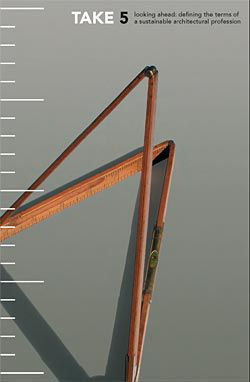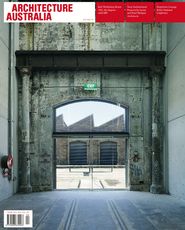
Andrew Nimmo reviews TAKE 5 – Looking ahead: defining the terms of a sustainable architectural profession, edited by Blair Gardiner, Anthony Mussen and Paolo Tombesi.
TAKE 5 is the product of the 2005 Sisalation Scholarship awarded to Paolo Tombesi, Blair Gardiner and Tony Mussen. It continues a worthy tradition of annual research stretching back to 1956, and is itself a significant historical record of issues worthy of research within the profession. Since 2001 the prize recipients have been required to edit the RAIA journal series TAKE, which becomes the written product of the scholarship. All five TAKEjournals can still be purchased through the RAIA.
Firstly, this is not a book about ESD. It is about the practice of architecture, “sustainable” being used in respect to sustaining an architectural profession into the future. The editors have sought to broaden analysis of the markets of the profession by including commentary from outside it. These important nonarchitect perspectives expand debate and reconnect the profession with the communal terrain of marketing, policy making, information technology, economic drivers, education and the role of the professional.
Readers should be warned, though – this is not a gripping read. It is a series of papers and interviews, some of which are very dry, working through the three core areas of “introspection”, “construction” and “policy”, with graphs and statistics as the principal graphic relief. That is not meant as a criticism; it’s just the nature of the product. Not all the topics are equally engaging, and it is hard to imagine anyone finding equal interest in them all. Each paper is quite short and self-contained, so you can dip into the book at any point of interest. However, a kind of narrative builds up through a series of brief commentaries from the editors between each paper that provide segues into the next paper or interview. This is also a clever way for the editors to manipulate subtly the intended reading of each section so that their argument is slowly built.
There are too many papers to cover in this review.
However, a smattering follows:
Margaret Bozik’s paper, “Architects as employees”, is an excellent precison the story of APESMA and the Architects Act, but strangely, for a book that is speculating on future trends, it has only a cursory look at the Howard Government’s WorkChoices legislation and its likely impact. Likewise, there is discussion about the perennial whinge that architects are underpaid compared to equivalent professions, but no analysis of why this is or what to do about it.
The two papers on the outsourcing of digital services through firms with staff based in comparatively low-wage nations such as India and Vietnam are advocacy pieces by people working in this field. What is missing is a contra view looking critically at the phenomenon. For example, what are the responsibilities of Australian firms in regard to the working conditions of contracted staff working in another country? How does outsourcing improve the architectural product and benefit the profession, or is it simply about the money? The growth of Occupational Health and Safety is discussed, particularly the legislative initiative to eliminate physical hazards at the design stage. This is a topic we will hear a lot more about in the coming years.
The current legislative framework and responsibilities are vague and awaiting a rash of alarming legal test cases to jolt the profession into taking the issue more seriously.
Michael Benedikt’s piece, “The Ghost of Gresham: Economics, architecture, and the progressive loss of designed value”, is one of the better reads and initiates a recurring discussion on the value of design.
It uses Gresham’s Law of economics to explain why “good” design will invariably be replaced with “less good” design while the value of “good” design is not universally appreciated. It suggests that education of the public may be the key, and that architects need to take responsibility for this task. Tim Culvahouse’s paper, “Explaining Design”, is a good companion piece to Benedikt’s paper, reminding us that communicating and selling the design is actually as important as creating it.
Mark Burry and John Frazer are interviewed on the development of Building Information Modelling (BIM), which is really the logical extension of CAD, yet it has some in the industry all hot and sweaty.
The more alarmist suggestions regarding the possible marginalization of the architect seem a little overstated.
Burry has the more philosophical view, reminding us that architecture is the object and BIM is the tool.
Will Hughes’ paper, “The future for the construction professions in Australia”, makes some very pertinent observations on the rise of the nonproductive culture of managerialism. He says, “No walk of life is safe from target-setting, performance evaluation, excessive documentation and objective yardsticks against which output can be measured.”
While the book covers a lot of territory, and probably does not do full justice to many of the issues, it inexplicably gives only a cursory coverage of ESD.
ESD is covered in part under the Burry/Frazer interview, again in the “Factors of Production” interviews, and again in the “Architecture in Government” interviews.
However, the real changes that sustainability is bringing to the profession – in terms of client demands, commercial competition, legislative changes and fundamental ethics – are enormous.
The promise of the introduction, that the Part 5 conclusion would “outline the points that should structure the professional agenda for a sustainable practice”, is unfortunately not delivered. Instead, the editors have chosen to pen a short and selective summary that makes few conclusions and doesn’t do justice to the extensive research and editorial work they have undertaken. This is followed by a revised version of the conclusion to Michael Benedikt’s 2003 manuscript, “The Value Of Architecture”, under the title “Eighteen proposals for revaluing architecture”. Benedikt’s proposals represent an amusing though obfuscatory perspective, but they seem out of place and indulgent here.
Throughout TAKE 5, two themes seem to develop.
Firstly, that architects need to keep their eyes and ears open – and be receptive to changing work practices as they emerge. Just as CAD has replaced manual drafting and alternative procurement has largely replaced traditional lump sum, the profession must be nimble and adaptable if it is to survive.
Secondly, that there is a need to explain to anyone who will listen what it is that architects do and how the architectural profession adds value to our society.
The word “value” is used quite a bit in the journal. Its meaning is extended beyond the obvious reference to commercial gains to include anything that characterizes worthy architecture or that separates the mediocre from the special. It advocates that architectural connoisseurship needs to be cultivated among the general public.
This, perhaps, is the real conclusion of the journal – that the profession cannot take its position in society for granted. The need to educate clients, the public, politicians, business leaders, developers – actually, anyone who is not an architect – about the value of good architecture never disappears.
Andrew Nimmo is a Director of Lahz Nimmo Architects.















